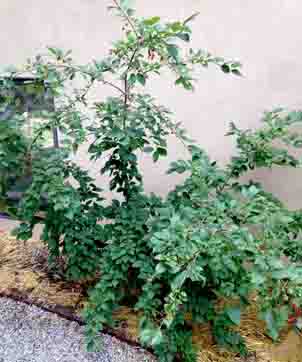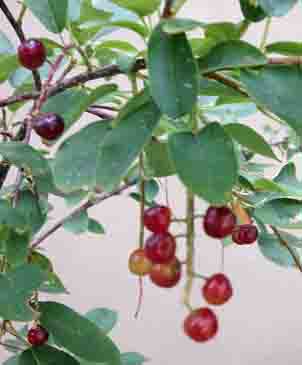 |
 |
Food:
"Choke cherries were among the most important berries for many tribes. They were collected after the first frost (which makes them sweeter) and were dried or cooked, often as an addition to pemmican or stews. Large quantities were collected, pulverized with rocks, formed into patties (about 6" or 15 cm) in diameter and 3/4' or 2 cm thick) and dried for winter use. Today, choke cherries are used to make jelly, syrup, sauce and wine. The raw cherries are sour and astringent, so they cause a puckering or choking sensation when they are eaten-hence the name 'choke cherry.' After they have been cooked or dried, however they are much sweeter and lose their astringency." (Kershaw 67)
"Only the black cherries are edible. All other parts of this plant are mildly poisonous-even the unripe red cherries. Ripe cherries can provide jelly, syrup, gelatin, wine, juice, fruit leather, and pemmican .Screen out the seeds. Dehydration preserves cherries for very long periods. --- Note: Like many commercial fruits, the seeds of chokecherry are mildly poisonous. Drying and heat evaporate toxic principles." (Seebeck 29)
Recipe: Chokecherry Jelly
"Wash cherries and remove stems. Simmer 4 cups chokecherries in enough water to cover the fruit. While simmering, mash the fruit with a wooden spoon. Remove from heat and run cherries through a Foley mill, retaining the liquid and pulp in a bowl below.
Put juice-pulp mixture back into a saucepan. Combine with 1 packet pectin. Bring to a boil and then add 1-2 cups sugar or other sweetener. Stir well. Bring to a rolling boil; continue boiling for 1 minute, stirring constantly. Remove from heat and place in jars. Store in refrigerator.
Note: For long-term storage use canning methods appropriate for jelly. Place in sterilized glass jars with sealed lids, as you would other jellies. Variation: Use half fresh apple cider and half chokecherry juice." (Morgan 212)
Medicine:
"The fruit is gathered for jam, jelly, and marmalade. Wine is made with the fruit juice, sugar, yeast, and water. This is allowed to stand for fifteen days, and is then strained and bottled with the addition of a little more sugar to each bottle. It should be kept for a month before drinking, and is considered a good purifier of the blood."
The people of Pena Blanca dig the roots in September (no other month will do) and boil them in water with a little piloncillo. A small glass of the warm tea is drunk the first thing in the morning and before every meal to relieve inflammation of the stomach. And for rheumatism, a red tea is made from the boiled roots. A small glass of this is drunk an the rest is used as a bath." (Curtin 37)
Other Uses:
"Crushed leaves or thin strips of bark will kill insects in an enclosed space. Cherry wood is very hard. Seasoned branches make excellent canes and walking sticks." (Kershaw 67)
"The racemes of white flowers, which are borne on the ends of its mahogany-colored branches, produce, in August and September, black cherries from which a purplish-red dye is extracted." (Curtin 37)
"In the early spring this plant is considered harmful to animals who eat its young leaves, but at this season of the year, if the outer bark is peeled off, its inner layer yields a green dye."(Curtin 37)
Internet Resources